The Intel Broadwell Xeon E3 v4 Review: 95W, 65W and 35W with eDRAM
by Ian Cutress on August 26, 2015 9:00 AM ESTProfessional Performance: Windows
Agisoft Photoscan – 2D to 3D Image Manipulation: link
Agisoft Photoscan creates 3D models from 2D images, a process which is very computationally expensive. The algorithm is split into four distinct phases, and different phases of the model reconstruction require either fast memory, fast IPC, more cores, or even OpenCL compute devices to hand. Agisoft supplied us with a special version of the software to script the process, where we take 50 images of a stately home and convert it into a medium quality model. This benchmark typically takes around 15-20 minutes on a high end PC on the CPU alone, with GPUs reducing the time.
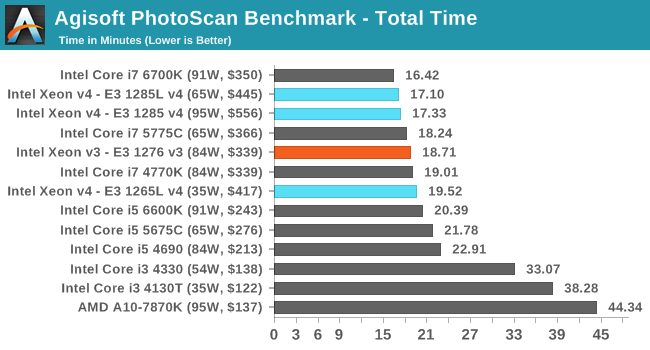
The benefits of the eDRAM here afford nearly two minutes over the v3.
Cinebench R15
Cinebench is a benchmark based around Cinema 4D, and is fairly well known among enthusiasts for stressing the CPU for a provided workload. Results are given as a score, where higher is better.
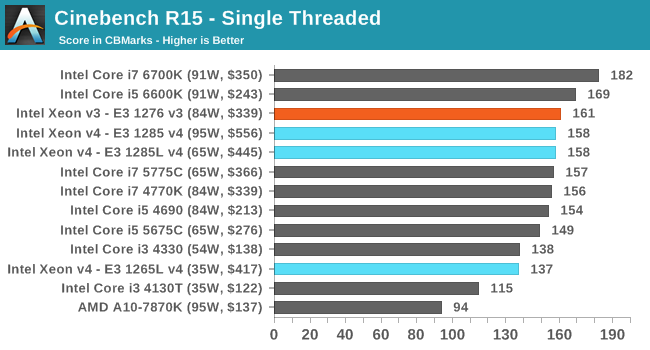

We've seen that Broadwell can organise threads slightly better than Haswell, along with its IPC increases and ability to manage more data in its buffers. As a result, while single thread is pretty much par for the course between the v3 and v4, the multithreaded result puts the v4 ahead of the v3.
HandBrake v0.9.9: link
For HandBrake, we take two videos (a 2h20 640x266 DVD rip and a 10min double UHD 3840x4320 animation short) and convert them to x264 format in an MP4 container. Results are given in terms of the frames per second processed, and HandBrake uses as many threads as possible.
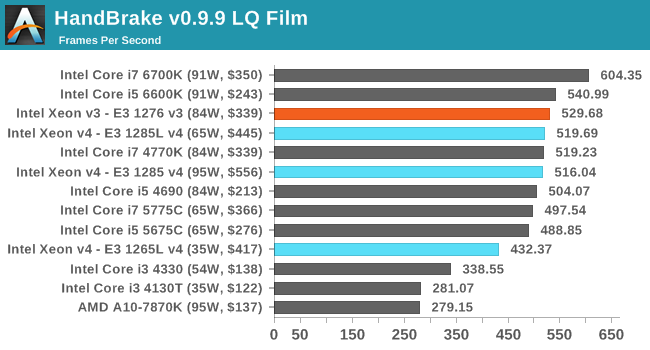
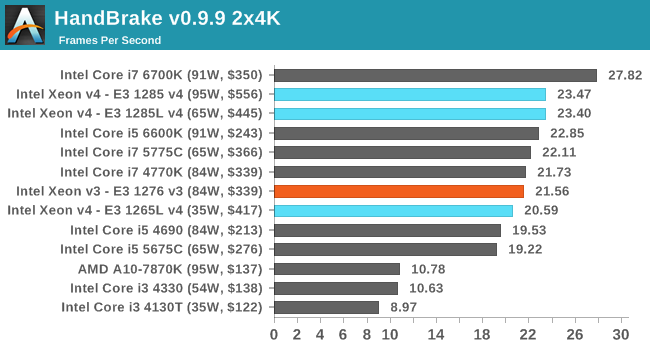
With our HandBrake tests, historically low quality encodes with small frames require a purely faster processor, whereas large high quality frames need more memory accesses. This is why the E3 v3 at 84W and E3 v4 at 35W come out near similar - the eDRAM of the v4 helps push a little ahead here. That being said, the improvements in Skylake show what perhaps the future v5 Xeons might be capable of.
Hybrid x265
Hybrid is a new benchmark, where we take a 4K 1500 frame video and convert it into an x265 format without audio. Results are given in frames per second.
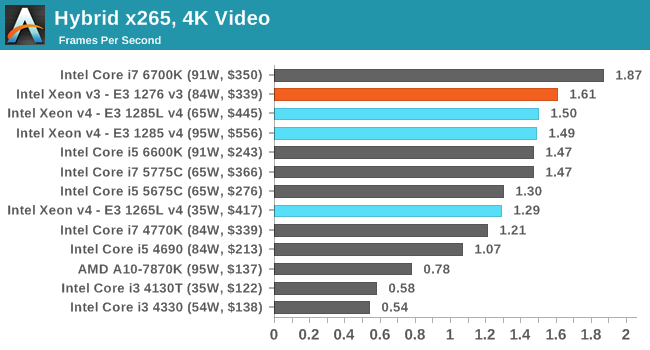










72 Comments
View All Comments
imaheadcase - Wednesday, August 26, 2015 - link
Its the GPU the put on the CPU. I wonder why they don't have performance CPU without the GPU part. Gamers don't buy a CPU for the GPU since they have dedicated one already.Maybe im missing something, but seems like wasted space they could use for gamer orientated instructions.
MrSpadge - Wednesday, August 26, 2015 - link
The advantage of the 14 nm transistors is higher at lower voltages. The 6700K is so massively "overvolted" in stock mode, it's operating far above this sweet spot. That's why I would have loved to what those chips can achieve, regarding power consumption and efficiency, at ~4.0 GHz and minimum voltages. Alas, noone else seems to care about that. Most reviews are just showing full throttle operation. AT measured at lower OCs as well (thanks for that!), but apparently did not even try to go below 1.20 V either. That's higher than the stock voltage of Sandy Bridge..Oxford Guy - Wednesday, August 26, 2015 - link
High voltage overclocking is more likely to sell expensive products for cooling and has the added benefit of burning out chips, leading to even more sales.Ian Cutress - Thursday, August 27, 2015 - link
If you're burning out your processor by overclocking, you're doing it wrong.Oxford Guy - Wednesday, August 26, 2015 - link
The 4790K used more than 88 watts. That was marketing magic.typographie - Wednesday, August 26, 2015 - link
Average framerates don't really seem to tell us very much when seemingly every game tested is GPU-limited with an i5 or better. Would it be possible to post minimum framerates and/or frame time variance in future CPU gaming benchmarks? I suspect there would be more practically useful differences between CPUs in that data.MrSpadge - Wednesday, August 26, 2015 - link
Agreed - those benchmarks are pretty boring. Some website (forgot which one) showed minimum fps advantages of the 6700K to be massive (20 - 50%) for some games. This might be the more interesting metric.TallestJon96 - Wednesday, August 26, 2015 - link
I agree, give us average and either minimum or 99th percentile frame rates. Averages typically are GPU bound, but minimums are often more CPU heavy.I would prefer 99th percentile over minimum, as it is more consistent.
Ian Cutress - Thursday, August 27, 2015 - link
Our minimum results, on some benchmarks, seem to be all over the shot. It only takes one frame to drop a result down, which may or may not be inconsistent. We still have those values - check them over at anandtech.com/bench.In response to TallestJon96 below, I'm working on pulling 99th percentile data in a regular, consistent way.
satai - Wednesday, August 26, 2015 - link
I would be pretty interested in some compilation benchmarks - does cache trumph frequency?